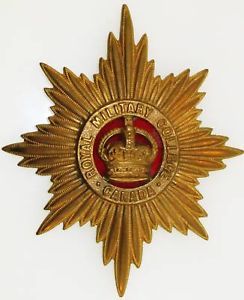Topic: Canadian Militia

Royal Military College of Canada (1891)
Northern Messenger, Montreal & New York, 17 April 1891
From an obituary/biographical sketch; Captain Huntley Mackey, R.E.
 The Royal Military College, of Canada, writes the assistant secretary to the High Commissioner for Canada to a London paper, was founded in Kingston in the year 1875, and was opened in June 1876 with a class of eighteen cadets and a staff consisting of a commandant, a captain of cadets, and three professors.
The Royal Military College, of Canada, writes the assistant secretary to the High Commissioner for Canada to a London paper, was founded in Kingston in the year 1875, and was opened in June 1876 with a class of eighteen cadets and a staff consisting of a commandant, a captain of cadets, and three professors.
The only available building at first was the old Naval Barrack at Point Frederick, now used as a dormitory. The present college building was completed in the summer of 1878; new batches of cadets were at first admitted every six months, and by June, 1878, when those who had originally joined completed their course, the number had increased to about ninety. The staff had in the meanwhile been gradually added to, and is now complete with a Commandant (Major-General; D.R. Cameron, R.A., C.M.G.), ten Professors, three Instructors, Staff-Adjutant, Medical Officer, and Paymaster, etc.
The total number of cadets approved for admission to the present date is about 250. Of these 235 actually joined. The number who have graduated is 135. The number of cadets who have, so far, been gazetted to commissions in the Imperial Army, between the Cavalry, Royal Artillery, Royal Engineers, and Infantry services, is sixty-nine. In addition to these ex-cadets have been appointed to Commissions in the Mounted Police of Canada, the Schools of Artillery, Schools of Infantry, and to the Staff of the Royal Military College.
Of the cadets who have not obtained military employment, the greater portion have become civil engineers, and the services of these gentlemen have been much sought after, and very highly valued, not only in Canada, but in the United States also. Two of the graduates are employed on the Hydrographical Survey of the Canadian Lakes, three on the Geological Survey, and about seven in other Government Departments. About thirty cadets took part in the suppression of the Rebellion in the Northwest in 1885. The present strength of the cadets is about eight-five, and this may be expected to increase, as some twenty-four may be admitted every year. The age of admission is over fifteen and under eighteen years of the 1st of January preceding the entrance examinations, which takes place annually in the month of June.
The College course, being a four years' one, allows ample time not only for a thorough military training, but also for the study of Civil Engineering, Civil Surveying, Physics, Practical Chemistry, and other subjects which are naturally of great use to cadets in civil life, the course comprising Military Drills, both Infantry, Artillery, and Engineer; Signalling, Fencing, Riding, tactics, Strategy, Military Administration and Law, Fortification and Military Engineering, Mathematics and Mechanism, Astronomy, Geology and Mineralogy, Chemistry and Electricity, etc.
The college possesses a small observatory, and a most valuable assortment of surveying instruments, a most complete chemical laboratory, physical apparatus of almost every description, and a good selection of drawing and other models.
All of this has been gradually built up, and, needless to say, at great expense to the Dominion. But the growth of the college in public estimation warrants the expenditure, and it is an institution of which Canada may well feel proud; in fact, its success has been so noted that it seems likely a similar college will shortly be started in Australia.
Would space admit, much more might be said in justice to the Royal Military College of Canada, tending, as it does, to develop a true and loyal spirit towards the Mother Country.

